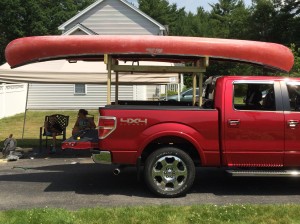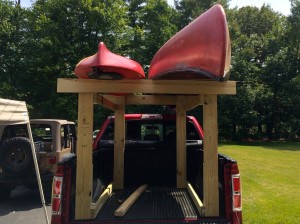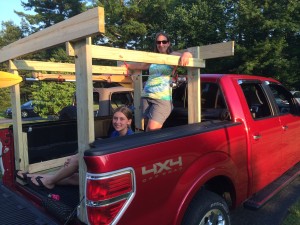Faced with the challenge of carrying a a 16′ Old Town canoe, a kayak and all the gear and accessories and camping supplies in the 5 and a half foot bed of my F-150 SuperCrew I set out looking for options. First and foremost how to transport the canoe without being a hazard on the road to myself or anyone else. The prerequisites were as follows:
1) Should allow safe operation of the vehicle
2) No drilling or permanent modifications to the truck and should not interfere with or require the removal of the toneau cover I have installed
3) Must be easy to remove and install
4) Loading the canoe must not be difficult
5) Should hold at least one canoe – two would be better
6) Should look halfway decent
7) And the ever present engineering requirement of cost
I found several worthy and interesting options. So I’ll start with each of them then explain why I went with a pencil and paper. First up is the “Extend-A-Truck” type receiver accessories. These allow you to carry extended loads such as canoe and ladders by hanging them off your truck bed onto this arm which hangs far off of the back of your truck. When in the lower position my 16 foot canoe would hang past the end of my truck 10 feet. This, in my opinion violates the first prerequisite, road safety. Not only that it prevent use of my backup camera and the tailgate would need to be down in order to transport the canoe. This would severely limit my ability to carry the camping gear as well.
In the upright position the upright would block the backup camera. I could still use my cargo bed, so long as I got an additional load bar for the cab ($150 for a foot pack + $100-150 for a load bar). Because the gunwale of the canoe has a six-inch rise in it from the center to the bow and stern it would need to clear the roof. This could work but it would still block my backup camera and is definitely starting to get into violating requirement seven (cost). For the $300+ cost of this setup I could buy another kayak. This setup would come easily off the truck but has a pretty singular purpose. Another issue is the cab is supposed to be decoupled from the rest of the bed. The whole frame is designed to twist a little when going over rough terrain. Mounting the canoe to both the cab and the bed could present rubbing and shifting problems. Based on these violations of the requirements I began to look elsewhere.
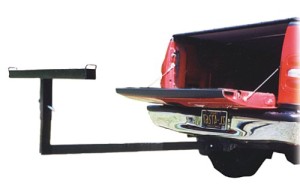
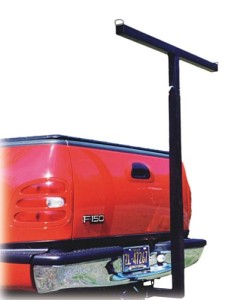
Next up I came across these started looking into Thule and Yakima roof racks. Why not just put the canoe where I put it on the mini-van in the past. Then after looking at the problem I decided against it. First these roof racks are ridiculously expensive for what they are. It wold again cost me close to what it would cost for a kayak to buy the roof rack. In light of this it would be pretty difficult to load the canoe onto the roof of a full size pickup truck. It would require someone to step-up walk it into the bed and then put it onto the roof…and when you put something on the roof, without fail, it will get scratched. Because of the cost and the unloading and loading difficulty of the canoe level these were nixed. (Photo from F-150 forum – a fantastic place for all your F-150 modifications, support and help.) Being so high on the truck a roof rack has certain disadvantages.
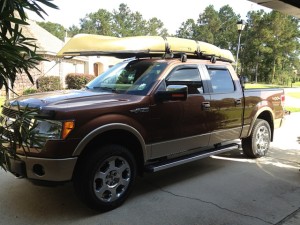
The last item I researched was back-rack style and Thule X-porter type racks. The back-rack style racks require modifications to the bed and/or drilling holes and welding. They would also completely restrict the use of my toneau cover. The Thule X-porter rack looked really nice but comes with a hefty price tag of nearly $700. In addition it would require the removal of my toneau cover to use. There are some less expensive models out there that are similar but they lack the accessories and have similar restrictions as the Thule racks. These would be a great choice if I didn’t have the toneau cover restriction since they can be raised up so the gunwale will clear the roof.
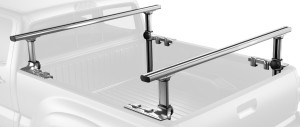
Running out of affordable, attractive and easy to use options I took to paper and sketched out what I I thought would work. This would be a multi use item. When not in the bed of my truck it would also server as a canoe and kayak stand. It would be built of materials I could easily obtain and it would be relatively inexpensive (orders of magnitude less expensive than the other solutions). My first thought was pressure-treated lumber. This will hold up to the elements, can be purchased locally and is relatively inexpensive. It requires only basic tools to work with and is strong an sturdy. I took to a sheet of paper and sketched this out:
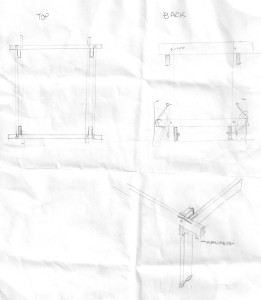
Armed with my sketch I headed to Home Depot to purchase materials. I originally sketched it out utilizing 2×4 pressure treated lumber but I made a decision to “beef up” certain structural members with 2×6 lumber for cost (surprisingly a 2x6x12 would produce less waste than 2x4x8 and would allow more fastening options. The bill of materials I used is as follows:
- (5) 2x4x8 #1 Pressure Treated (@ $3.27/each)
- (3) 2x6x12 #1 Pressure Treated (@7.97/each)
- (4) 5/16 x 4″ Eye Lag Screws (@$0.67/each)
- 1/4×3 Simpson Strong Drive Screw 50-pack (@17.32/box)
Total Cost of materials $60.26
Armed with my 10″ miter saw and my impact driver, speed square and pencil I got started. First I measured how high I wanted the uprights. These needed to allow to gunwale to not touch the roof with the canoe hanging over the cab and to allow an extra inch or two of clearance in between. 4 uprights were cut out of 2 of the 2x6x12s. These would be placed so they would more or less lock against the tailgate of the bed when it was up to prevent wobbling. I had to change up the positioning of some of the vertical elements to work around the non-ideal bedliner (scooped out versus square corners in the back) and to inset slightly to work around the mounting hardware of the toneau cover. I bungeed these in place while I worked out the rest of the structure. Next I cut the top-cross bars. I wanted these to extend out to the edges of the bed to maximize the width so I could carry multiple canoes or kayaks. Both top cross members were cut from the same 2x6x12 to the same width. With the supports bungeed up where they belonged the distance between them was measured (note they were not up against the edge of the bed to account for the toneau mounts which overhang).
With the measurements in hand the rear most top-crossbar was measured out and screwed together nice and square on the ground. After doing some calculations to inset the rear uprights inside of the base spreader the rear was screwed together. The base stringers were then screwed onto the front support and put back into the bed of the truck. The location of the cab side of the upright was adjusted, squared up and screwed into place. The distance between the front and rear supports was carefully measured adding in the width of the 2×6 on each end. This measurement was used to cut two more 2x4x8s to the proper length. These were then fastened to the uprights. The add a little extra structural support under the crossbars due to the way they are mounted. At this point the rack was pretty rock solid. I drilled a pilot hole for the eye lag screws and installed them where I though they would work and screwed them in. From these I can attached ratchet straps for a little extra piece of mind to hold the rack down to the bed.
The tailgate was put up and we threw the canoe and kayak onto the rack to see how they fit. Perfect! I later added a few “J” hooks to the top spreaders to carry paddles and fishing poles. While it’s not the perfect solution it meets all the requirements and is multi-purpose. Further it allows for easy loading and unloading of cargo and doesn’t block the backup camera. It’s easy to unload it from the bed and utilize it as a stand-alone rack. The rack I had built many years ago for holding up the canoe is now falling apart. Two problems solved with one design.
